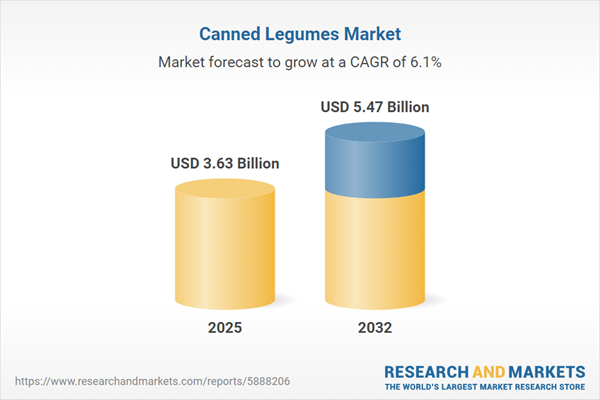Speak directly to the analyst to clarify any post sales queries you may have.
Senior decision-makers in the canned legumes market are navigating a landscape shaped by shifting procurement models, regulatory complexity, and increasing sustainability requirements. Understanding these evolving drivers is essential for optimizing supply chain performance, maintaining compliance, and seizing new opportunities in a diversifying marketplace.
Canned Legumes Market Snapshot: Growth and Opportunity
The canned legumes market is exhibiting sustained growth, fueled by rising institutional and enterprise sourcing of plant-based protein and continued adaptation across foodservice, retail, and direct-to-consumer segments. Analysts project the market will grow from USD 3.42 billion in 2024 to USD 3.63 billion in 2025, reaching USD 5.47 billion by 2032, representing a steady compound annual growth rate of 6.05%. Partnerships between suppliers and large buyers have been expanding, as product portfolios diversify and operational resilience becomes increasingly critical. Digital transformation within procurement and the push for logistical adaptability are opening doors for suppliers to enhance engagement. Agility in adjusting to complex supply chain and regulatory changes is proving vital for retaining competitive positioning.
Canned Legumes Market Scope & Segmentation
- Product Types: Includes canned beans, chickpeas, lentils, mixed legumes, and peas, supporting a broad array of uses from large-scale manufacture to custom foodservice applications.
- Distribution Channels: Spans supermarkets, hypermarkets, convenience stores, online platforms, direct-to-consumer strategies, and wholesale networks, broadening procurement options and market accessibility.
- End Users: Addresses bulk requirements of foodservice operators who value reliable supply, as well as retailers seeking consumer-ready solutions for evolving dietary needs.
- Cultivation Methods: Encompasses both organic and conventional farming methods, promoting sustainability credentials and compliance for buyers in standard and premium segments.
- Packaging Formats: Offers single-serve and bulk packaging, optimizing handling for retail, efficiency for e-commerce logistics, and adaptability for institutional buyers.
- Geographic Coverage: Covers North America, Latin America, Europe, Middle East, Africa, and Asia-Pacific. Each region demonstrates unique regulatory demands and distribution characteristics, prompting tailored supply chain responses and regulatory strategies.
- Company Coverage: Profiles leading suppliers such as Conagra Brands, Bonduelle, B&G Foods, Amy's Kitchen, The Hain Celestial Group, Campbell Soup Company, Goya Foods, General Mills, The J. M. Smucker Company, and Nestlé, each advancing innovation and channel reach to reinforce supply relationships.
Key Takeaways for Senior Decision-Makers
- Responsible sourcing practices are increasingly compulsory for brand reputation and alignment with evolving transparency expectations from regulators and end customers.
- Adoption of digital procurement platforms streamlines supplier interactions and increases efficiency, strengthening both commercial and institutional buyer connections.
- Continuous investment in supply chain modernization, including advancements in processing and smart packaging technology, enhances resilience to logistical uncertainty.
- Sustainable packaging solutions act as a point of differentiation and help fulfill large customer and government sustainability requirements.
- Geographic market behavior highlights that environmental considerations shape demand in the Americas, traceability remains key in Europe, and convenience in procurement channels influences purchasing in Asia-Pacific.
- Strategic collaborations and operational partnerships foster supply reliability and help organizations manage complex, shifting regulatory or trade dynamics.
Tariff Impact and Policy Dynamics
Recent changes in U.S. tariff policy are prompting manufacturers and distributors in the canned legumes sector to refine cost management tactics and diversify sourcing channels. There is an emphasis on stable procurement strategies to address potential disruptions, making regulatory alignment a core element of long-term business and supply chain planning.
Methodology & Data Sources
This market analysis is predicated on direct interviews with industry leaders and experts, complemented by insights from certified secondary data sources. These rigorously verified inputs underpin the actionable recommendations tailored for executive decision-making in the canned legumes market.
Why This Report Matters
- Enables supply chain leaders to refine operational and procurement strategies by integrating digitalization and automation advancements across the sector.
- Clarifies risk assessment frameworks to help organizations anticipate compliance shifts and proactively plan investments, thereby improving resilience.
- Serves as a practical reference for leadership, supporting efforts to protect market positions and ensure operational continuity during sector transitions.
Conclusion
Ongoing innovation in sourcing, digital adoption, and compliance standards continues to strengthen organizational adaptability. These factors help ensure resilient strategies and sustained growth within the canned legumes sector.
Additional Product Information:
- Purchase of this report includes 1 year online access with quarterly updates.
- This report can be updated on request. Please contact our Customer Experience team using the Ask a Question widget on our website.
Table of Contents
3. Executive Summary
4. Market Overview
7. Cumulative Impact of Artificial Intelligence 2025
Companies Mentioned
The companies profiled in this Canned Legumes market report include:- Conagra Brands, Inc.
- B&G Foods, Inc.
- Bonduelle S.A.
- The Hain Celestial Group, Inc.
- Goya Foods, Inc.
- The J. M. Smucker Company
- Campbell Soup Company
- General Mills, Inc.
- Amy's Kitchen, Inc.
- Nestlé S.A.
Table Information
| Report Attribute | Details |
|---|---|
| No. of Pages | 192 |
| Published | November 2025 |
| Forecast Period | 2025 - 2032 |
| Estimated Market Value ( USD | $ 3.63 Billion |
| Forecasted Market Value ( USD | $ 5.47 Billion |
| Compound Annual Growth Rate | 6.0% |
| Regions Covered | Global |
| No. of Companies Mentioned | 11 |









